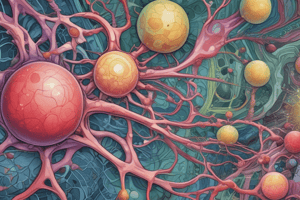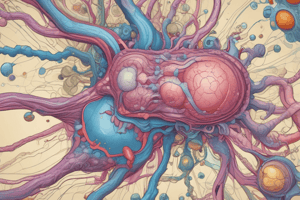Podcast
Questions and Answers
What is the basic structural and functional unit of life?
What is the basic structural and functional unit of life?
- Organ
- Organ System
- Cell (correct)
- Tissue
What is the main function of epithelial tissue?
What is the main function of epithelial tissue?
- Forms outer linings, glands, and organs (correct)
- Transmits and processes information
- Provides support and structure
- Enables movement and contraction
What is composed of two or more types of tissue?
What is composed of two or more types of tissue?
- Organ System
- Tissue
- Organ (correct)
- Cell
What is the group of organs that work together to perform a specific function?
What is the group of organs that work together to perform a specific function?
What is the primary component of the nervous tissue?
What is the primary component of the nervous tissue?
What is the function of the circulatory system?
What is the function of the circulatory system?
What is the main function of muscle tissue?
What is the main function of muscle tissue?
What is the main function of connective tissue?
What is the main function of connective tissue?
Flashcards are hidden until you start studying
Study Notes
Organisation in Animals
Levels of Organisation
- From simplest to most complex:
- Cells
- Tissue
- Organ
- Organ System
Cells
- Basic structural and functional units of life
- Carry out specific functions, e.g. muscle contraction, nerve conduction
- Made up of:
- Plasma membrane
- Cytoplasm
- Genetic material (DNA or RNA)
Tissue
- Group of similar cells that perform a specific function
- Four main types:
- Epithelial tissue: forms outer linings, glands, and organs
- Connective tissue: provides support, structure, and connectivity
- Muscle tissue: enables movement and contraction
- Nervous tissue: transmits and processes information
- Tissues work together to form organs
Organ
- Structure composed of two or more types of tissue
- Performs specific functions, e.g. heart pumps blood, liver detoxifies
- Examples:
- Heart: muscle and connective tissue
- Liver: epithelial, connective, and blood tissue
- Brain: nervous and connective tissue
Organ System
- Group of organs that work together to perform a specific function
- Examples:
- Circulatory system: heart, blood vessels, blood
- Nervous system: brain, spinal cord, nerves
- Digestive system: mouth, esophagus, stomach, intestines, etc.
- Organ systems interact to maintain homeostasis and ensure overall functioning of the organism
Organisation in Animals
Levels of Organisation
- Cells are the basic structural and functional units of life
- Tissue is a group of similar cells that perform a specific function
- Organs are structures composed of two or more types of tissue
- Organ systems are groups of organs that work together to perform a specific function
Cells
- Made up of plasma membrane, cytoplasm, and genetic material (DNA or RNA)
- Carry out specific functions, such as muscle contraction and nerve conduction
Tissue
- Four main types: epithelial, connective, muscle, and nervous tissue
- Epithelial tissue forms outer linings, glands, and organs
- Connective tissue provides support, structure, and connectivity
- Muscle tissue enables movement and contraction
- Nervous tissue transmits and processes information
- Tissues work together to form organs
Organ
- Examples: heart, liver, brain
- Heart is composed of muscle and connective tissue
- Liver is composed of epithelial, connective, and blood tissue
- Brain is composed of nervous and connective tissue
- Organs perform specific functions, such as pumping blood or detoxifying
Organ System
- Examples: circulatory system, nervous system, digestive system
- Circulatory system is composed of heart, blood vessels, and blood
- Nervous system is composed of brain, spinal cord, and nerves
- Digestive system is composed of mouth, esophagus, stomach, intestines, etc.
- Organ systems interact to maintain homeostasis and ensure overall functioning of the organism
Studying That Suits You
Use AI to generate personalized quizzes and flashcards to suit your learning preferences.




